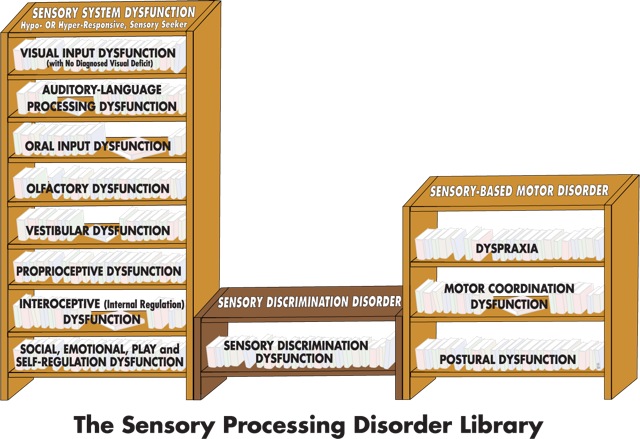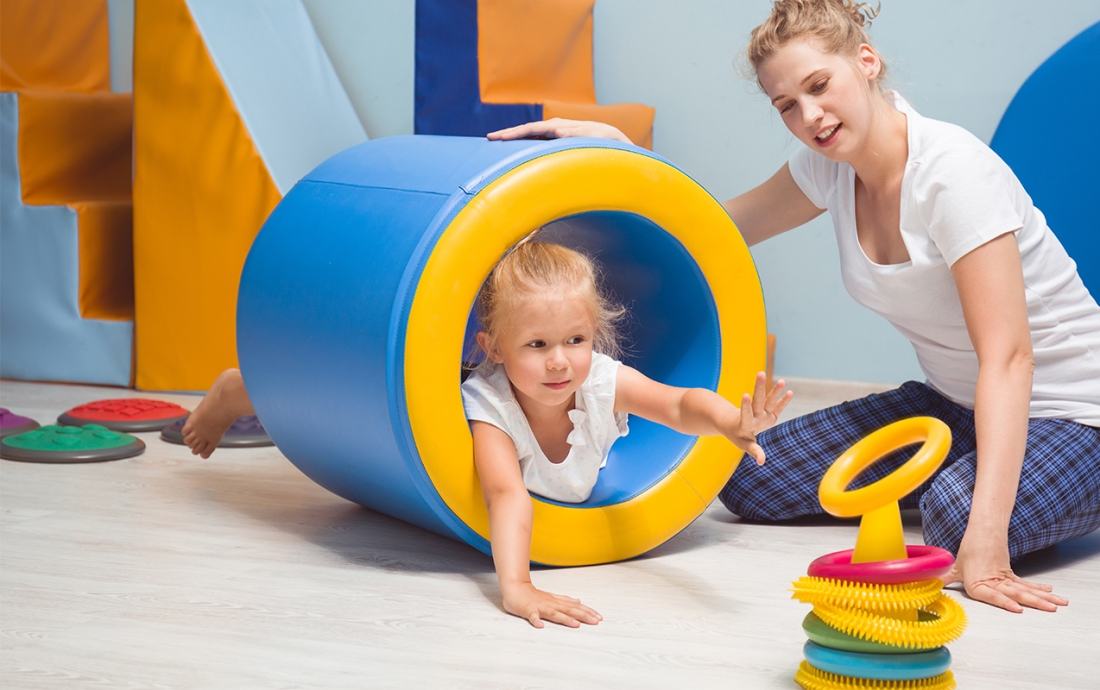
We left off last post by noting that all the sensory processing disorders fall into three basic categories, and within those categories, dysfunctions can occur related to one or more of the eight senses. The above graphic provides a visual way to consider the different categories/types of SPD, discussed below.
Sensory System Dysfunction Overview
Incoming sensations from our environment are adjusted and balanced in our brain’s Central Nervous System (CNS), ready for our behavioral response. Our sensations advise us when we do not like a certain feeling (e.g., spinning too fast) or when we are in danger and need to stop.
But sometimes people have problems regulating the intensity and nature of their responses to everyday sensory input. The responses may be emotional or behavioral. The person may withdraw, or have strong negative responses to sensations that do not bother others.
The responses can be categorized as follows:
Sensory Over-Responder
This person may be hypersensitive to touch, get easily distressed and respond in extreme ways, take a long time to calm down after becoming upset, often run away, lash out, or hide. S/he will be easily distracted because his/her brain is alert to all sensations, even those that are not useful. This inability to filter irrelevant from relevant information may cause him or her to defend himself.
Sensory Under-Responder
This person may be hyposensitive to touch, always appear withdrawn, disengaged, tired, take a long time to get going, clumsy. S/he will react less intensely to sensations and need lots of stimulation to remain alert or even get going.
Sensory Seeker (wants more sensations)
This person is in high need of sensory input, has a desire to touch everything, craves movement, takes risks, is often seen as a trouble-maker.
Sensory System Dysfunction Sub-Types
Sensory System Dysfunction is the largest category. Most of these sub-types are self-explanatory. Here are a few points about how dysfunctions in the less-familiar far senses may manifest themselves:
Vestibular Dysfunction:
If we do not receive or process input from our inner ear about equilibrium, gravitational changes, movement experiences, and position in space, this could result in poor muscle tone and/or coordination.
Proprioceptive Dysfunction:
If we do not receive or process input from our muscles and joints about body position, weight, pressure, stretch, movement, and changes in position in space, this could manifest in sensory-seeking behaviors, difficulty with “grading of movement” (the ability to use the correct amount of pressure and/or force when performing tasks), and/or hyposensitivity to sounds (under-responsiveness).
Interoceptive (Internal Regulation) Dysfunction:
If we do not perceive or process internal bodily sensations, we won’t know when we are hungry, thirsty, tired, sick, need the bathroom, etc. (hypo-responsive) or, conversely, we may be hyper-responsive and and over-react to pain, hunger, etc. Plus, our ability to read our own physical signals directly relates to how well we can understand and regulate our emotional signals, which also directly impacts our ability to identify another person’s physical and emotional cues.
To sum up, perhaps we can best understand Sensory System Dysfunction by thinking about reading a book that discusses both the dysfunction (which sense is not functioning well; see the shelf categories) AND the form it takes (how is that sense not functioning well; hyper-responding, hypo-responding, or seeking more sensations).
Sensory Discrimination Disorder Overview
Sensory Discrimination is the ability to differentiate between sensory stimuli. This discrimination allows us to perceive the qualities of sensations (what am I feeling?); similarities of sensations (have I felt/heard/seen/etc. this before?); and differences between sensations (so we can respond appropriately).
As a person develops and matures, ideally s/he becomes more discriminatory about the environment and what is happening around him/her. But a person with poor tactile perception has problems processing body sensations from touch, muscles and joints (proprioception), and head movements (vestibular– inner ear sensations), and thus does not develop the ability to discriminate between sensations (touch, pressure, temperature, pain, etc.).
Sensory Discrimination Disorder in More Detail
Sensory Discrimination Dysfunction:
A person with Sensory Discrimination Dysfunction is also known as a sensory jumbler, having difficulty differentiating between stimuli. S/he may be confused by basic concepts, have poor body awareness, fall frequently, have trouble distinguishing word sounds, use inappropriate force with objects, and bump into people and objects. His/her Central Nervous System (CNS) inaccurately processes sensations, so is unable to use this information to respond appropriately, learn about his/her environment, and relate to other people.
Sensory-Based Motor Disorder Overview
As the CNS receives, modulates, and processes incoming sensory messages the second they are received, the brain sends outgoing messages directing the person to move and act appropriately within his/her environment. These effective sensory-based motor skills involve postural responses and praxis.
Postural responses allow the person’s trunk, neck and head to remain upright against the pull of gravity. With good muscle tone a person can reach and stretch his/her muscles in order to manipulate objects, swing, shift his/her weight from foot to foot and spin around without losing balance.
Praxis (doing, action, practice) is based partly on unconscious sensory processing and partly on conscious thought. Motor planning is a term used when discussing praxis, which allows a person to efficiently plan his/her next steps and organize his/her body to carry out the plan.
Sensory-Based Motor Disorder Sub-Types
Dyspraxia
Someone with dyspraxia, also known as a sensory fumbler, moves slowly, is clumsy, has awkward motor skills, misjudges where objects are, and lacks motivation. Dyspraxia refers to disruption in sensory processing and motor planning in children who are still developing. These children may have normal intelligence and muscle function, however, the brain-to-body connection is disrupted and thus produces inaccurate information about touch, movement, and body position. Children with dyspraxia have problems planning, sequencing and/or executing unfamiliar actions. This often causes emotional insecurity as the brain tells the child “I can’t do that.”
Motor Coordination Dysfunction:
Someone with motor coordination dysfunction may drop things, run into walls/furniture, and fall or trip often. They may be unable to judge spatial distances and have difficulty shutting off faucets, turning off devices, putting together puzzles or toys, and/or performing other complex tasks requiring hand-eye coordination. They may have problems with complex motor activities such as dancing, gymnastics, catching or throwing a ball with accuracy, holding a pencil, or writing fluently and legibly. They often suffer from low self-esteem as well as academic underachievement. Infants may be either “floppy” or “rigid;” other symptoms include tremors, an above average muscle tone, and problems with smooth movement.
Postural Dysfunction:
Someone with postural dysfunction, also known as a sensory slumper, has poor posture, slumps, has trouble keeping up with others, has difficulty with tasks requiring coordination, and finds movement activities daunting. S/he may have poor muscle tone; i.e., be loose and floppy. This issue may be due to inefficient vestibular and proprioceptive sensory processing about where his/her body is in space and what it is doing.
Looking ahead:
In the next few posts, we’ll discuss how occupational therapy can help, no matter what type of SPD your child has, and the role of the occupational therapist as “sensory investigator,” working with sensory children to create individualized therapy plans and strategies for success.
What is particularly helpful to you in understanding the type of SPD your child has been diagnosed with and its ramifications? Please share your thoughts in the comments section below. Also, let me know there or via email what topics you would like to discuss or hear more about.
In Conclusion:
Sensory Processing Disorder Treatment leads to difficulty with the senses. jumptherapy.org has occupational therapy for children with Sensory Processing Disorder.Also, it provides specialized services for children experiencing sensory processing disorders, fine and gross motor delays, and handwriting difficulties. Browse our website for more details about Autism Therapy for Your Child, Sensory integration therapy for kids, Autism Resources for Parent, sensory integration therapy nj, social skills therapies for kids, autism treatment for toddlers, gross motor therapy for children, Occupational Therapist Fair Lawn, pediatric occupational therapy nj.
Read Also: My Child Has Sensory Processing Disorder
40.937001
-74.118123




